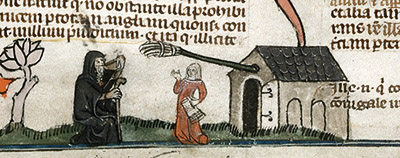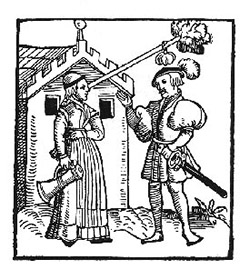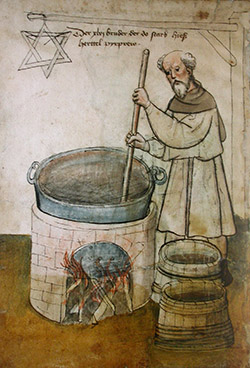The rules for selling beer in cities of Prussia
It's not enough to brew beer, you also need to sell it. Let's talk about how beer trade was organized in the city in the 15th-18th centuries.
Beer trade in the city
The rules for selling beer in different cities of Prussia differed from each other.
For example, in Domnau (now Domnovo in the Kaliningrad region), which received city rights in 1400 (confirmed in 1480), among others, the townspeople had the following privileges: the right to maintain 7 taverns and 4 butcher shops; a reserved mile for taverns and crafts; the right to sell beer at fairs, a ban on retail trade for visitors (except on fair days).
The town of Preußisch Eylau (now Bagrationovsk in the Kaliningrad region) was once a lishka ( lishka, lishke, liska - a village in Prussia, usually located near a castle, populated by artisans and having a tavern), near which the Eylau castle was built in 1325. The oldest privilege that has come down to us (1348) was granted to the village by the commander of Balga. The charter grants 12 local innkeepers land holdings on the basis of the Kulm law, and gives the right to sell not only beer, but also everyday goods - meat, flour, bread, fish. Until 1585, the settlement did not have city rights. Citizens turned to Duke Georg Friedrich with a petition to grant the community city rights. In the petition, the liška was already called a "small town", and out of 12 taverns, only 8 remained at the disposal of the residents. The remaining 4 belonged to the duke. The residents expressed their willingness to pay the tavern tax annually and asked that 4 ducal taverns be transferred to them. The use of these taverns was supposed to be alternately between the owners of the land plots. The owners of the entire plot (its size is not specified) would like to brew beer for sale once every 4 weeks and pay a tavern tax of 3-4 marks for this, and the owners of half a plot - once every 6 weeks with two tax marks. The residents also asked to allow them to build public malthouses and breweries, as well as to hold a weekly market. The owners of the remaining 8 taverns could continue their activities as before.
On November 30, 1585, the Duke issued the long-awaited charter, in which the requests were satisfied. The city received ordinary city rights and the right to a weekly market, a fair, etc., in accordance with their Vilkurs (a Vilkur is a legal act issued by the city government). The city was given 4 taverns on the terms proposed by the residents, the tavern fee was set at 3 marks for a whole plot, and 1.5 marks for a half. The rights of the city tavern keepers remained in force. The townspeople were allowed to build a malthouse and a brewery at their own expense, and the ducal forester was ordered to supply firewood and timber for the needs of brewing on an equal basis with the local tavern keepers.
In Elbing in the 16th century, members of the brewers' guild were prohibited from selling beer wholesale. In taverns, beer was sold only at retail, pouring no more than a shtof (1.4 l) at a time. Interestingly, members of the porters' guild played an important role in the beer trade, providing not only transport services, but also wholesale trade in alcoholic beverages.
According to the law of 1636, only residents of Elbing could sell beer. A tax was paid to the city treasury on the beer sold. Innkeepers often took beer on credit, becoming debtors to suppliers. The magistrate forbade changing beer suppliers until the debt for the supplied beer was fully repaid, as well as leaving the city. Retail sales of beer were often carried out by the beer producers themselves, and sometimes it happened that a brewery was located in one house, and beer could be bought there at retail. Wholesale prices for beer (per barrel), as well as retail prices (per decanter), were set by the city authorities. Special inspectors monitored compliance with beer prices, as well as the volumes poured in taverns.
In theory, pub owners had the right to choose their beer suppliers. But in practice, disputes often arose between beer producers, some of whom were also members of the city council and used their position to lobby for the promotion of their products, especially in the surrounding villages. In some cities, city government regulations prohibited forcing pub owners to buy beer from a specific supplier, giving them the right to choose independently. In Marienburg, the line between wholesale and retail beer was often blurred, and beer producers sold their products themselves. But regardless, in all cities, beer prices were set by city authorities.
In some cities, beer trade, as well as its production, was given to city residents on a first-come, first-served basis. For several weeks a year, every burgher willing to sell beer became the owner of a drinking establishment. As a rule, the first floor of a residential building (at best), or a large room on the ground floor, was temporarily transformed into a kind of pub. In order for the city residents and visitors to be able to understand which of the houses was selling beer at the moment, a bundle of brushwood was hung by the door, and in the evening a brazier with fire was set up. Such temporary pubs were given the right to offer their visitors only beer (for example, in the already mentioned Fischhausen, a house that had the right to sell beer on a first-served basis was marked with a sign saying “Good beer here”). Providing accommodation and food to guests remained the prerogative of hotels and inns, which could also receive the right to sell beer.

The right to brew beer and then sell it in their homes was a symbol of the high social status of a city dweller. This right was passed on by inheritance, along with real estate. If the real estate passed into the hands of a new owner, he could also receive the beer right along with it. The sale of a house with a beer privilege was most often caused by the owner's financial difficulties.
City authorities, who received considerable revenue from beer sales, often allocated cellars in city hall buildings for the retail sale of beer.

Beer production in Prussian villages
There were problems connected with supplying the cities with products produced in the villages. Elbing and Danzig are good examples of the situation. All the surrounding taverns were obliged to buy their own liquor in the city. The example of Marienburg is very specific. Each village in the territory of the Marienburg economy had a tavern, sometimes even 2-3. At the end of the 16th century, in 64 villages of the Marienburg economy, the burghers of Marienburg owned 50 taverns, having a monopoly right to supply them with beer.
The organization of beer production in estates and large manors differed from the city primarily in that one master supervised both the preparation of malt and the process of brewing beer.
Another peculiarity of village brewing was that in some villages every peasant had the right to brew beer for himself for a wedding or funeral, as well as other similar celebrations. Most often this happened in villages populated by people from Holland, when the community bought the right to brew and sell beer for itself. There were cases when individual peasants brewed beer on their own using the master's equipment, paying the owner for its rent.
The right to brew beer for their own needs was held by peasants in many villages during sowing and harvesting. Some rich peasants bought individual rights to brew beer. In the Tolkemite starostvo, as early as the second half of the 17th century, residents had the right to brew three barrels of beer a year for their own needs.

Sources:
Andrzej Klonder. Two brothers from the Prussian Crown Princes (2nd half of the 16th-17th centuries). — World History of Polish Academy of Sciences, Wrocław, 1983.
Rogachevsky A.L. Essays on the history of Prussian law in the 13th-17th centuries. - St. Petersburg, Publishing House of the Law University, 2004.
